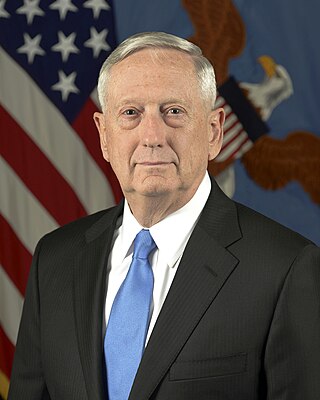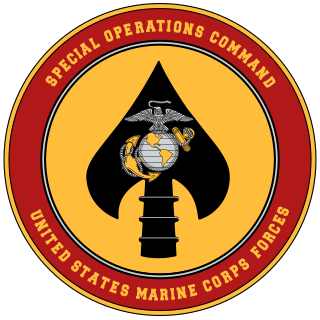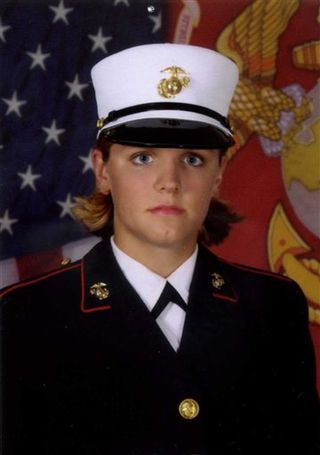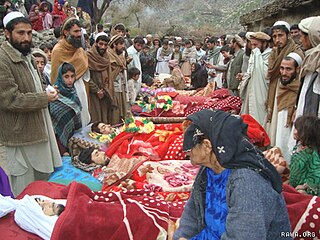Related Research Articles

James Norman Mattis is an American military veteran who served as the 26th United States secretary of defense from 2017 to 2019. A retired Marine Corps four-star general, he commanded forces in the Persian Gulf War, the War in Afghanistan, and the Iraq War.
Charles William Gittins is an American lawyer, who has worked for a number of noteworthy defendants in military courts martial.

United States Marine Forces Special Operations Command (MARSOC) is a component command of the United States Special Operations Command (SOCOM) that comprises the Marine Corps' contribution to SOCOM. Its core capabilities are direct action, special reconnaissance and foreign internal defense. MARSOC has also been directed to conduct counter-terrorism and information operations.

1st Battalion, 5th Marines (1/5) is an infantry battalion in the United States Marine Corps based out of Marine Corps Base Camp Pendleton, California consisting of approximately 800 Marines and sailors. Nicknamed Geronimo, it falls under the command of the 5th Marine Regiment and the 1st Marine Division. The battalion was formed in 1914 and has served in every major conflict that the United States has been involved in since then.

The Haditha massacre was a series of killings on November 19, 2005, in which a group of United States Marines killed 24 unarmed Iraqi civilians. The killings occurred in the city of Haditha in Iraq's western province of Al Anbar. Among the dead were men, women, elderly people and children as young as 1, who were shot multiple times at close range while unarmed. The ensuing massacre took place after an improvised explosive device exploded near a convoy, killing a lance corporal and severely injuring two other marines. The immediate reaction was to seize 5 men in a nearby taxi and execute them on the street.

Frank D. Wuterich is a former United States Marine Corps Staff Sergeant who pleaded guilty to negligent dereliction of duty as a result of his actions during the Haditha massacre where multiple innocent civilians were murdered. As a result of the plea agreement, he was reduced in rank to Private. He was given a general discharge in February 2012.

The following items form a partial timeline of the War in Afghanistan. For events prior to October 7, 2001, see 2001 in Afghanistan.
Colby Vokey is an American lawyer and former officer in the United States Marine Corps. He currently practices criminal defense law in his own private practice. He represents clients in all types of criminal matters, with particular emphasis on cases involving military law. Vokey earned the rank of lieutenant colonel and served as a judge advocate in the United States Marine Corps during 21 years of service to his country. His retirement from the Marine Corps became effective November 1, 2008. During his military career, Vokey earned worldwide praise for his work ethic and integrity, based in part on his work for defendants detained at Guantanamo Bay, Cuba, who faced charges stemming from the war in Iraq.

Lance Corporal Maria Frances Lauterbach of Vandalia, Ohio, was a United States Marine who disappeared from Marine Corps Base Camp Lejeune, North Carolina on December 14, 2007. At the time of her disappearance, Lauterbach was eight months pregnant. Authorities found the remains of Maria Lauterbach and her unborn child in the backyard of Corporal Cesar Armando Laurean, who was extradited from Mexico in 2009 and convicted of murder in 2010.
Members of the United States Armed Forces have violated the law of war after the signing of the Hague Conventions of 1899 and 1907 and the signing of the Geneva Conventions. The United States prosecutes offenders through the War Crimes Act of 1996 as well as through articles in the Uniform Code of Military Justice. The United States signed the 1999 Rome Statute but it never ratified the treaty, taking the position that the International Criminal Court (ICC) lacks fundamental checks and balances. The American Service-Members' Protection Act of 2002 further limited US involvement with the ICC. The ICC reserves the right of states to prosecute war crimes, and the ICC can only proceed with prosecution of crimes when states do not have willingness or effective and reliable processes to investigate for themselves. The United States says that it has investigated many of the accusations alleged by the ICC prosecutors as having occurred in Afghanistan, and thus does not accept ICC jurisdiction over its nationals.
There were 2,459 United States military deaths in the War in Afghanistan, which lasted from October 2001 to August 2021. 1,922 of these deaths were the result of hostile action. 20,769 American servicemembers were also wounded in action during the war. In addition, 18 Central Intelligence Agency (CIA) operatives also died in Afghanistan. Further, there were 1,822 civilian contractor fatalities.
Events from the year 2008 in Afghanistan.

The Marine Raider Regiment (MRR), formerly known as the Marine Special Operations Regiment (MSOR), is a special operations force of the United States Marine Corps, which is a part of Marine Corps Special Operations Command (MARSOC). Renamed for its predecessor, the World War II Marine Raiders, this unit is the principal combat component of MARSOC, which is the Marine Corps' contribution to the United States Special Operations Command (USSOCOM).

The night raid onNarang was a night raid on a household in the village of Ghazi Khan in the early morning hours of December 27, 2009. The operation was authorized by NATO and resulted in the death of ten Afghan civilians, most of whom were students, and some of whom were children. The status of the deceased was initially in dispute with NATO officials claiming the dead were Taliban members found with weapons and bomb making materials, while some Afghan government officials and local tribal authorities asserted they were civilians.

The Maywand District murders were the thrill killings of at least three Afghan civilians perpetrated by a group of U.S. Army soldiers from January to May 2010, during the War in Afghanistan. The soldiers, who referred to themselves as the "Kill Team", were members of the 3rd Platoon, Bravo Company, 2nd Battalion, 1st Infantry Regiment, and 5th Brigade, 2nd Infantry Division. They were based at FOB Ramrod in Maiwand, in Kandahar Province of Afghanistan.

The Battle of Ganjgal took place during the War in Afghanistan between American and Afghan forces and the Taliban in Kunar Province, Afghanistan on September 8, 2009. Complaints that the coalition casualties were avoidable and caused by a failure of the chain of command to provide fire support for the team triggered an official investigation and a series of reprimands to several US military officers. Army Captain William D. Swenson and Marine Corporal Dakota Meyer received the Medal of Honor for their actions during the battle. Meyer is the first living Marine to receive the Medal of Honor since the Vietnam War, and Swenson is the fifth living soldier and second officer to receive the Medal of Honor since the Vietnam War. Two other Marines at the battle, Staff Sgt. Juan Rodriguez-Chavez and Capt. Ademola Fabayo, received the Navy Cross.

The 1st Marine Raider Battalion is a special operations forces of the United States Marine Corps and a subordinate combat component of the Marine Corps Special Operations Command. The Battalions' organization was finalized in 2006 and is one of three battalions of the Marine Raider Regiment.
On the morning of 1 March 2019, Taliban gunmen and suicide bombers attacked Camp Shorabak in Helmand Province, Afghanistan. They killed 23 Afghan soldiers and injured another 15. Twenty insurgents were killed. None of the US Marine advisers stationed at the military base were injured.
War crimes in Afghanistan covers the period of conflict from 1979 to the present. Starting with the Soviet invasion of Afghanistan in 1979, 40 years of civil war in various forms has wracked Afghanistan. War crimes have been committed by all sides.
References
- ↑ Prince, Stephen (13 August 2013). Firestorm: American Film in the Age of Terrorism. Columbia University Press. p. 210. ISBN 978-0231148702 . Retrieved 6 May 2015.
South Asia Defence and Strategic Year Book. Panchsheel. 2009. p. 254. Retrieved 6 May 2015.
Tucker, Spencer C., ed. (8 October 2010). Encyclopedia of Middle East Wars, The: The United States in the Persian Gulf, Afghanistan, and Iraq Conflicts . ABC-CLIO. p. 1368. ISBN 9781851099481.
Danes, Kay (2010). Beneath the Pale Blue Burqa: One Woman's Journey Through Taliban Strongholds. Big Sky Publishing. p. 110. ISBN 978-0980658286 . Retrieved 6 May 2015. - ↑ Carlotta Gall (8 April 2014). The Wrong Enemy: America in Afghanistan, 2001–2014 . Houghton Mifflin Harcourt. p. 115. ISBN 978-0-544-04568-2.
The thirty-man platoon was hit by a suicide car bomb in the midst of heavy traffic at a village called Spinpul.
- ↑ Talton, Trista; Naylor, Sean D. (15 February 2008). "The story of 'Task Force Violence'". Marine Times. Retrieved 6 May 2015.
- ↑ "Marine court hears dueling depictions of accused Archived 9 November 2023 at the Wayback Machine ", Los Angeles Times , 30 January 2008
- ↑ "Army colonel again criticizes Marine unit Archived 9 November 2023 at the Wayback Machine ", Los Angeles Times , 24 January 2008
- 1 2 3 4 5 6 Walsh, Declan (26 July 2010). "Afghanistan war logs: How US marines sanitised record of bloodbath". The Guardian . London. Archived from the original on 29 July 2010. Retrieved 26 July 2010.
- 1 2 Michael Haas (2009). George W. Bush, War Criminal?: The Bush Administration's Liability for 269 War Crimes. ABC-CLIO. p. 53. ISBN 978-0-313-36499-0.
Investigation began in early 2008 for those involved in the Shinwar massacre. Six Marines were granted immunity to testify. Their testimony served to exonerate those not granted immunity, thereby infuriating Afghanistan's human rights commission.
- 1 2 3 "Many Afghans outraged at US decision on Marines". NewsOK . Associated Press. 6 June 2008. Retrieved 6 May 2015.
- 1 2 3 Jepson, Kris (27 July 2010). "Afghan shootings raise war crimes question". Channel 4. London. Retrieved 5 May 2015.
- ↑ "Wounded Afghans say U.S. forces fired on civilians after suicide bomb". USA Today. United States. Associated Press. 4 March 2007. Retrieved 6 May 2015.
- ↑ World Almanac of Islamism 2011. Rowman & Littlefield. 2011. p. 827. ISBN 978-1-4422-0714-1.
- 1 2 Faiez, Rahim (3 May 2007). "U.S. forces flee Afghan ambush firing wildly". Current-Argus. Archived from the original on 8 July 2011. Retrieved 11 September 2009.
- 1 2 Iqbal, Anwar (16 April 2007) "Marines killed civilians in Afghanistan: report", Dawn.com
- ↑ "U.S. investigating reports of Afghan civilians killed by its military forces ", AlaskaReport [ permanent dead link ], 5 March 2007
- ↑ "US Seizes Afghan Shooting Footage Archived 16 January 2008 at the Wayback Machine ", Al Jazeera English , 6 March 2007
- ↑ Bright, Arthur (16 April 2007) "Pentagon inquiry finds US Marine unit killed Afghan civilians. Csmonitor , 16 April 2007
- ↑ "US Revises Downward Number of Civilians Killed in Afghan Convoy Attack". VOA News. Archived from the original on 6 March 2007. Retrieved 22 March 2012.
- 1 2 Baxter, Sarah (15 April 2007). "US troops accused of killing civilians". The Sunday Times. London. Retrieved 17 April 2007.
- 1 2 3 4 5 Zucchino, David (24 January 2008). "Army colonel again criticizes Marine unit". Los Angeles Times. Retrieved 27 May 2015.
Talton, Trista; Naylor, Sean D. (15 February 2008). "The story of 'Task Force Violence'". Marine Corps Times. Retrieved 27 May 2008. - ↑ "US 'excessive' in Afghan attack". BBC News. 15 April 2007. Retrieved 16 March 2008.
- ↑ "US 'erased Afghan attack footage'". BBC News. 5 March 2007. Archived from the original on 15 March 2007. Retrieved 18 April 2007.
- ↑ Tyson, Ann Scott (23 March 2007). "Marine Unit Is Told To Leave Afghanistan". Washington Post. Archived from the original on 21 August 2011. Retrieved 11 September 2009.
- ↑ Gall, Carlotta (15 April 2007). "Marines Accused in Afghanistan Slayings". The New York Times. Retrieved 17 April 2007.
- ↑ Kevin Baker (2011). War in Afghanistan. Rosenberg Publishing Pty, Limited. p. 221. ISBN 978-1-921719-39-4.
- ↑ "H07L105376221" (PDF). Office of Inspector General. United States Department of Defense. 10 July 2008. Archived from the original (PDF) on 23 September 2015. Retrieved 6 May 2015.
"Probe backs commander who removed Marine unit". WHEC. Rochester, New York. Associated Press. 16 September 2008. Retrieved 6 May 2015. - ↑ "Rights group assails U.S. marines in killings of Afghans – International Herald Tribune". Archived from the original on 15 April 2007.
- ↑ Cloud, David S. (9 May 2007). "U.S. Pays and Apologizes to Kin of Afghans Killed by Marines". The New York Times. Retrieved 27 May 2015.
In a videoconference to reporters at the Pentagon, he added, "We made official apologies on the part of the U.S. government" and paid $2,000 for each death.
- ↑ Talton, Trista (15 January 2008). "Payments to Afghans detailed at MarSOC inquiry". Navy Times. Retrieved 1 June 2015.[ dead link ]
- ↑ "9 Afghan Civilians Killed in NATO Strike". CBS News. 5 March 2007. Retrieved 23 December 2008.
- ↑ deGrandpre, Andrew (3 April 2015). "Task Force Violent: The unforgiven". Military Times. Retrieved 27 May 2015.
Zucchino, David (26 January 2008). "Marine Humvee was shot at, Army expert testifies". Los Angeles Times. Retrieved 27 May 2015.Mero, who examined the Humvee within two days of the March 4 incident, said he was pressured by the Air Force colonel in charge of the investigation to alter his conclusions.
- ↑ "Probe: US Marines killed civilians in Afghanistan | Jerusalem Post". Fr.jpost.com. 3 February 2012. Archived from the original on 17 September 2011. Retrieved 3 March 2012.
- ↑ "Navy: No Proof to Marines' Ambush Story". Navy: No Proof to Marines' Ambush Story. Associated Press. 15 January 2008. Retrieved 1 June 2015.
- ↑ von Zeilbauer, Paul (20 April 2015). "Killings of Afghan Civilians Recall Haditha". The New York Times. Retrieved 5 May 2015.
- 1 2 3 "Pentagon apologizes for deaths of Afghan civilians". CNN. 8 May 2007. Retrieved 22 April 2010.
Nicholson, John (8 May 2007). "DoD News Briefing with Col. Nicholson from Afghanistan". United States Department of Defense. Archived from the original on 28 May 2015. Retrieved 27 May 2015. - ↑ Lowe, Christian (18 May 2007). "Conway Condemns Afghanistan Apology". Military.com. Retrieved 3 March 2012.
- ↑ Talton, Trista (11 October 2007). "Court of inquiry ordered in spec-ops case". Marine Times. Gannett. Retrieved 6 May 2015.
- 1 2 3 David Zucchino (24 May 2008). "Marine Corps unit cleared in Afghan shootout". LA Times. Retrieved 10 September 2009.
- ↑ "Ex-Marine testifies in Afghan deaths tribunal". NBC News. Associated Press. 8 January 2008. Retrieved 1 June 2015.
Thompson, Estes (9 January 2008). "Civilians died needlessly, former marine tells court of inquiry". Welland Tribune. Canada. Archived from the original on 4 March 2016. Retrieved 1 June 2015. - ↑ Meek, James Gordon (21 February 2013). "Helped U.S. Win Cold War; Marines Killed His Family". New York Daily News. Retrieved 1 June 2015.
Zucchino, David (23 January 2008). "2 Afghans testify in Marine inquiry". Los Angeles Times. Retrieved 1 June 2015. - ↑ Zucchino, David (30 January 2008). "Marine court hears dueling depictions of accused". Los Angeles Times. Retrieved 1 June 2015.
He said the U.S. military made payments to the families of 17 dead listed by the governor, but a later Navy investigation put the number of dead at five to seven. And despite reports that children and women had been killed, Waple said, testimony produced only a wounded 16-year-old boy and a woman with a hand injury.
- 1 2 deGrandpre, Andrew (19 March 2015). "Task Force Violent: The unforgiven". Military Times. Archived from the original on 21 May 2015. Retrieved 27 May 2015.
- ↑ Talton, Trista (28 June 2008). "MarSOC report: More investigation needed". Marine Corps Times. Retrieved 27 May 2015.
- ↑ Seck, Hope Hodge (21 February 2015). "MARSOC remains a growing, changing force after 9 years". Marine Corps Times. Retrieved 27 May 2015.
- ↑ "Task Force Violent: The unforgiven | Part 3". 12 February 2018.
- ↑ deGrandpre, Andrew (2015). "Task Force Violent: The Unforgiven". Military Times. Garnett. Retrieved 5 May 2015.
- ↑ deGrandpre, Andrew (16 February 2017). "The military blackballed these Marines. Four congressmen are fighting to restore their honor". MilitaryTimes. Springfield, Virginia: Sightline Media Group. Retrieved 17 March 2017.
- ↑ "Breaking: US Navy to fix what the Marine Corps wouldn't by clearing MARSOC Fox Company commander from false accusations of war crimes". 7 January 2019.